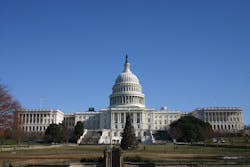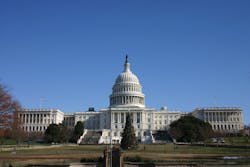The US's drinking water and wastewater infrastructure is in deep trouble – the US Environmental Protection Agency estimates that at current levels of expenditure, the gap between actual and needed levels of investment in water infrastructure will be in excess of $300 billion over the next 20 years.
WWi investigates.
Water and wastewater infrastructure in US currently faces a long list of issues. Aging infrastructure, increasing regulations, energy costs and funding are all issues which the country needs to address.
According to Tami Ray, director at Black & Veatch's management consulting division, while many US utilities are incorporating asset management and sustainability measures in an effort to decrease cost, there remains a financing gap for capital projects.
"The US EPA estimates a total of more than $632 billion of infrastructure investment needs in water and wastewater up to the year 2028. Other organisations, such as the US Conference of Mayors, estimate investment needs by 2028 to be upward of $2.8 trillion. While traditional financing venues remain, there is a desire to 'bridge the gap' between necessary infrastructure improvements and available funding," explains Ray.
The American Water Works Association (AWWA), Water Environment Federation (WEF) and Association of Metropolitan Water Authorities (AMWA), have undertaken their own research on the situation and the likely effects of this massive infrastructure funding deficit.
The fruit of their labours has been the creation of a Water Infrastructure Finance and Innovation Authority (WIFIA), modeled on the successful Transportation Infrastructure Finance and Innovation Act (TIFIA), to resolve these issues.
Accessing funds from the Federal Treasury at long-term Treasury rates, WIFIA funds would be used to provide loans or other kinds of credit support to major - $20 million plus – projects or State Revolving Funds (SRFs) wanting to increase their capital. Loan repayments, with interest, would flow back to WIFIA and thence to the Treasury, so WIFIA would have no net long-term effect on the federal budget, the organisations argue.
AWWA's director of legislative affairs, Tommy Holmes, explains that the financial option represented by WIFIA "is something we came up with after study. I like the way we did it. The studies pushed us in the direction of WIFIA."
"Water and wastewater infrastructure is paid for by local rates and charges, so we were driven to look for the lowest cost, but still doing the job right. The most cost efficient way was WIFIA, which will provide low-cost financing and fills the gap in existing Federal programmes to finance water infrastructure," he continues.
Holmes adds that while the SRFs have done good things, most states are unable to finance projects over $20 million and a tool to finance these larger infrastructure projects is needed.
"SRFs tend to be prioritised at what is the most immediate threat to public health. So if you are a utility safely in compliance but wanting to rehabilitate, you go to the bottom of the list. We want to rehabilitate infrastructure before it's a problem – an engineer can fix anything with enough money, it's just a lot more expensive to fix after it's broken," says Holmes.
WIFIA Explained
The way that WIFIA would work is critical to understanding the benefits of this financing approach. Under US law, a federal entity can only provide credit assistance to the extent that Congress annually appropriates budget authority to cover the "subsidy cost" of a loan – that is, the net long-term cost of the loan to the Federal government, which is based on the risk of default.
In the case of TIFIA the leverage ratio is around ten to one – every $1 in subsidy supports $10 in credit assistance, a figure that may be even higher for the water sector, Holmes believes.
"Every dollar from WIFIA will result in $33 being loaned out," he estimates. "Historically, US water utilities have a loan default rate of 0.04 per cent, and most of these are resolved in a couple of years."
Holmes goes on to explain that WIFIA will be housed within the US EPA. When a loan application is made, the regulator will evaluate the project and its creditworthiness and make a loan. "Another beauty of the project is that it is long-term budget neutral. The era of grant programmes is over," he adds.
The Water Environment Federation's government affairs expert Tim Williams notes that: "in the environment we are in at the moment, a programme that can provide funding without a cost to the Treasury is attractive."
The need for funding is far greater than the money available through the SRF regardless of its limitations, he notes. "The numbers are very large," says Williams. "A lot of pipes and plants were built at the time they passed the original environmental laws in the 1970s, and these are now at the end of their replacement life in many cities. There are still pipes in the ground that are 100 years old. It is a replacement era we have to finance."
WIFIA provides the sort of low interest, direct-finance funding for larger sums that can be combined with other sources of revenue to fund projects that would otherwise struggle to get sufficient financing, he notes.
According to Williams the entire industry and the states and municipalities themselves, with big responsibilities to fulfill and pressured by having been through the worst financial downturn in 30 or 40 years, are also anxious for solutions.
"There are various proposals such as a trust fund or a national tax that would go into a fund to pay for local projects. WIFIA is one tool in the toolbox – on its own it will not solve the gap, but it will solve the shortcomings of the current programme, which does not fund larger projects," he adds.
Stormy waters ahead?
According to AMWA's director of legislative affairs, Dan Hartnett, US drinking water infrastructure requires at least $384 billion worth of rehabilitation and upgrades over the next two decades.
"WIFIA's affordable low-interest loans will help communities pay the bill, while its leveraging structure and loan-payback requirements will avoid burdening the federal government with new debt," he explains.
"Investing in our water infrastructure is good for the economy, good for communities, and good for public health. WIFIA will be a win-win for local water ratepayers and federal taxpayers," concludes Harnett.
The first House of Representatives hearing on the bill occurred on 19 September.
CH2M HILL vice president for federal affairs, Matt Chiller explains that the Senate overwhelmingly passed its version of the Water Resources Development Act (WRDA) in a bi-partisan show of support, and that the House of Representatives Committee on Transportation and Infrastructure has now finalised its version of the bill. However, he also cautions of worrying news.
"Their bill does not include WIFIA. This is nuanced – the House supports WIFIA, and the people on the Committee support it as well, but they didn't want the bill to get too far into issues around the Clean Water Act and the US EPA," he explains.
This fear of possible controversy does not mean WIFIA is dead, however.
According to Chiller once the House Bill has been debated a number of representatives from both the House and Senate will then be chosen for the Conference stage.
"We are very hopeful that the House will accept WIFIA. We are hopeful they will because they support it in concept. We are going to advocate it, and many water industry-related people in Washington will as well."
Industry support
According to Mike Matichich, firm-wide practice area lead for financial services at CH2M HILL, a number of water industry associations have been putting out position papers and making known their support, for which there has been "keen interest".
Matichich explains that WIFIA is seen as an important resource in addition to leading-edge approaches to private financing such as the West Coast Infrastructure Exchange, which brings together the states of California, Oregon, Washington and British Columbia in a framework agreement.
Black & Veatch's Tami Ray notes that financing is a difficult issue at the current time.
"Today's economic concerns have delayed many critical infrastructure projects and created a post-recession risk aversion in the municipal bond market," says Ray.
Chiller adds that the 2011 Budget Control Act brought in "pretty strict" budget caps over the next ten years that mean the Federal government's scope to provide funding for major projects is limited. Large infusions of capital will have to come from elsewhere.
Struggle states and bankrupt cities
With California having struggled to pass its budget and the bankruptcy of Detroit, Matichich observes that states and municipalities are looking for new ways to deliver finance, such as PPPs or design-build-operate-finance packages.
Bundling projects, as in the West Coast Infrastructure Exchange, provides the sort of scale ($150 million plus) that many such groups are interested in. Most large municipal projects, while larger than SRF funding could support, are between $30 million and $75 million and therefore too small in themselves to be attractive, Matichich adds.
He also notes that WIFIA is an important element of the solution because "the impact on consultants and other project delivery groups such as construction contractors follows the interests of clients. If the pipeline of needed projects is stalled, the need for consulting and contractor support to advance projects slows in relation".
Chiller meanwhile adds that one of the attractions of WIFIA is its broad array of eligibility - projects as disparate as desalination, rehabilitation, energy efficiency and flood control could all be funded.
Water and Wastewater Equipment Manufacturers Association (WWEMA) president, Dawn Kristof-Champney notes that given the funding gap and trying economic times, "WIFIA is a creative option that provides [larger cities] access to lower-cost capital from the US Treasury with limited to no impact on the federal budget as funds are repaid to the Treasury with interest.
"It is a true form of public-private partnership that is warranted if we are to protect public health by ensuring the integrity of our nation's water supply and wastewater treatment systems."
She explains that the current situation is having a grave effect on equipment manufacturers. "Without access to affordable capital, our municipalities are unable to maintain or upgrade existing projects or invest in new ones. This has had a crippling effect on the water and wastewater equipment market, viewed by many these days as "in the toilet".
"With the exception of a few pockets driven by regulatory mandate – such as nutrient removal or combined sewer overflow reduction – and the occasional, though increasingly frequent, distribution system malfunctions, business for the most part is flat or contracting, with little cause for optimism anytime in the immediate future.
"The majority of projects that do exist involve small orders for spare parts. The few big projects attract swaths of competitors bidding at rock-bottom prices in order to sustain their businesses during this economic slump," adds Kristof-Champney.
WIFIA, she feels, is the shot in the arm that the industry needs. "WIFIA provides a means for resuscitating the market and moving projects forward. This will benefit all sectors of the industry, including municipal employees, consulting engineers, contractors, equipment manufacturers, sales representatives and – most important – the consumer, who benefits from the life-sustaining services our industry provides."
Concerns
However, she does issue a warning: "The one aspect of this legislation that gives us grave cause for concern is the prospect of requiring compliance with Buy American as a condition of receiving these funds. The readership of Water and Wastewater International is undoubtedly aware of the unintended consequences associated with restrictive domestic procurement rules that limit competition, increase costs, delay projects, add administrative burdens, and put equipment manufacturers at risk of being locked out of foreign markets as other countries replicate such practices in their government procurement and public works projects."
WWEMA is also working to advance the Sustainable Water Infrastructure Investment Act, which Kristof-Champney believes "has the potential to bring $5 billion annually in private investment in water and wastewater infrastructure projects".
Conclusions
Despite the clear need and enthusiasm for WIFIA, the need for a clear rationale for projects must remain, cautions Tami Ray.
"Many utilities continue to struggle with needed capital improvements that may not be supported by significant business case. These projects need a small degree of public assistance to become viable and affordable at the local level," she says.
"Consideration must be given to affordability and effectiveness when planning for projects that address our nation's water security and safety. A criterion has been established by the US EPA to weigh these considerations and provide financial assistance to encourage these projects. It is important the same considerations be addressed by WIFIA," concludes Ray.
This article was written by WWi magazine. For more information, contact: [email protected]






